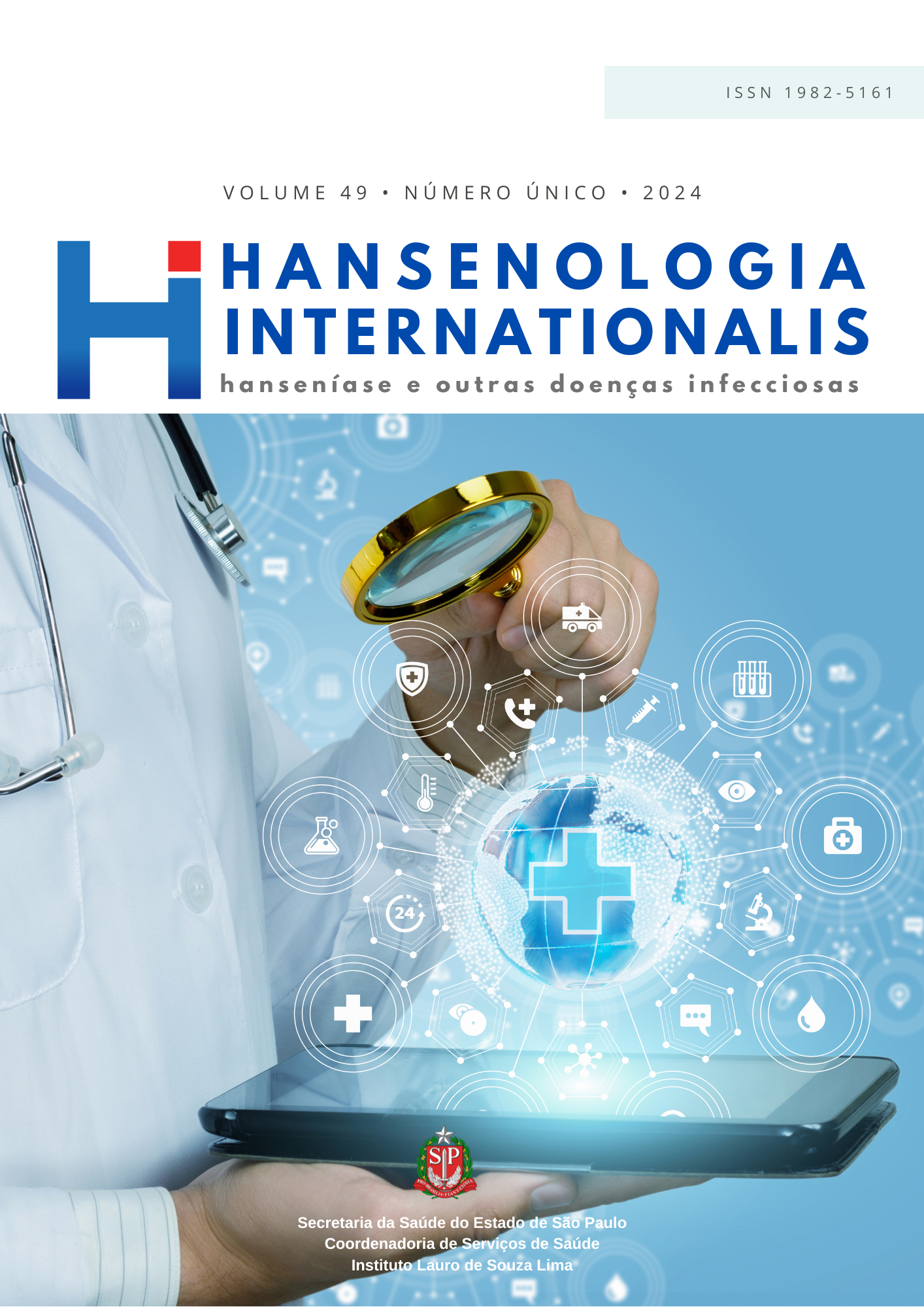Abstract
Introduction: leprosy is a chronic granulomatous disease caused by Mycobacterium leprae. Objective: the study aims to report the follow-up of a patient with leprosy, presenting a positive quantitative polymerase chain reaction (qPCR). Case description: the patient is a 53-year-old male residing in the rural area of São Geraldo da Piedade, Minas Gerais State, Brazil. In 2015, the patient sought care at the Governador Valadares Municipal Central Polyclinic and was referred to the Dr. Alexandre Castelo Branco Reference Center for Endemic Diseases and Special Programs (CREDEN-PES) to initiate treatment. However, he did not adhere to the therapy, citing difficulty accessing the center. In 2017, he returned to CREDEN-PES, where he was examined and collected material for bacilloscopy and qPCR. The bacilloscopy index (BI) result was zero and positive for qPCR. The patient was referred for treatment in his hometown and adhered to two doses of multibacillary multidrug therapy (MB-MDT). In 2021, he sought CREDEN-PES for new evaluations, resulting in BI = 1.5 and decreased plantar sensitivity. He began a unique treatment regimen for leprosy (U-MDT). In 2023, he moved to Paraná State and recently reported his condition: regular health, altered balance, frequent falls, loss of strength in the knees, dry skin, and swelling behind the ear. The positivity of the qPCR reaction prompted the team to follow up with this patient, who initially did not adhere to the treatment. Conclusion: it is believed that using laboratory tools to assist and reinforce the diagnosis and treatment has contributed to more effective leprosy control.
References
1. Scollard DM, Adams LB, Gillis TP, Krahenbuhl JL, Truman RW, Williams DL. The continuing challenges of leprosy. Clinical Microbiology Reviews. 2006;19(2):338-81. doi: https://doi.org/10.1128/cmr.19.2.338-381.2006.
2. Leite MLC, Miranda MCR, Pugedo AC, Grossi MAF, Ramalho KC, Costa JV. Situação epidemiológica da hanseníase Minas Gerais – municípios silenciosos – 2009-2018. 10º Simpósio Brasileiro de Hansenologia. Hansen Int. 2019;44(Suppl.1):e-2684. doi: https://doi.org/10.47878/hansenologia.2019.v44.34050.
3. Minas Gerais (Estado). Plano Estadual de Saúde 2020-2023. Belo Horizonte: Secretaria de Estado de Saúde de Minas Gerais; 2020. [citado em 20 fev. 2023]. Disponível em: https://www.saude.mg.gov.br/images/1_noticias/09_2021/01_jan-fev-marc/08-02-Plano-Estadual-de-Saude%20-de-Minas-Gerais%20%202020-2023.pdf.
4. Kang TJ, Kim SK, Lee SB, Chae GT, Kim JP. Comparison of two different PCR amplification products (the 18-kDa protein gene vs. RLEP repetitive sequence) in the diagnosis of Mycobacterium leprae: PCR for diagnosis of M. leprae. Clinical and Experimental Dermatology. 2003;28(4):420-4. doi: https://doi.org/10.1046/j.1365-2230.2003.01300.x.
5. Goulart IMB, Goulart LR. Leprosy: diagnostic and control challenges for a worldwide disease. Archives of Dermatological Research.
;300(6):269-90. doi: https://doi.org/10.1007/s00403-008-0857-y.
6. Gama RS, Gomides TAR, Gama CFM, Moreira SJM, Manta FSN, Oliveira LBP, et al. High frequency of M. leprae DNA detection is asymptomatic household contacts; BMC Infectious Diseases. 2018;18(153):1-6. doi:https://doi.org/10.1186/s12879-018-3056-2.
7. Gama RS, Souza MLM, Sarno EN, Moraes MO, Gonçalves A, Stefani MMA, et al. A novel integrated molecular and serological analysis method to predict new cases of leprosy amongst household contacts. PLoS. Negl. Trop. Dis. 2019;13(6):e0007400. doi: https://doi.org/10.1371/journal.pntd.0007400.
8. Pinheiro MDS, Oliveira NG, Santos DCM, Leite HM, Baptista IMFD, Fairley JK, et al. Impact of qPCR on the diagnostic evaluation of
individuals with suspected leprosy. Research, Society, and Development. 2023;12(3):e13312340549. doi: https://doi.org/10.33448/rsdv12i3.40549.
9. Martinez AN, Britto CFPC, Nery JAC, Sampaio EP, Jardim MR, Sarno EN, et al. Evaluation of real-time and conventional PCR targeting complex 85 genes for detection of Mycobacterium leprae DNA in skin biopsy samples from patients diagnosed with leprosy. Journal of Clinical Microbiology. 2006;44(9):3154-9. doi: https://doi.org/10.1128/jcm.02250-05.
10. Martinez AN, Lahiri R, Pittman TL, Scollard D, Truman R, Moraes MO, et al. Molecular determination of Mycobacterium leprae viability by use of real-time PCR. Journal of Clinical Microbiology. 2009;47(7):2124-30. doi:https://doi.org/10.1128/jcm.00512-09.
11. FIOCRUZ [Internet]. Rio de Janeiro: Fiocruz; 2021. [atualizado em 21 set. 2021; citado em 30 dez. 2023]. Menezes M. Fiocruz cria teste molecular para hanseníase inédito no Brasil. [aproximadamente 1 página]. Disponível em: https://portal.fiocruz.br/noticia/fiocruz-cria-testemolecular-para-hanseníase-inedito-no-brasil.

This work is licensed under a Creative Commons Attribution 4.0 International License.
Copyright (c) 2024 Marcos Daniel Silva Pinheiro, Maisa Pereira Vieira, Daisy Cristina Monteiro dos Santos, Alexandre Castelo Branco, Lorena Bruna Pereira de Oliveira, Lucia Alves de Oliveira Fraga
